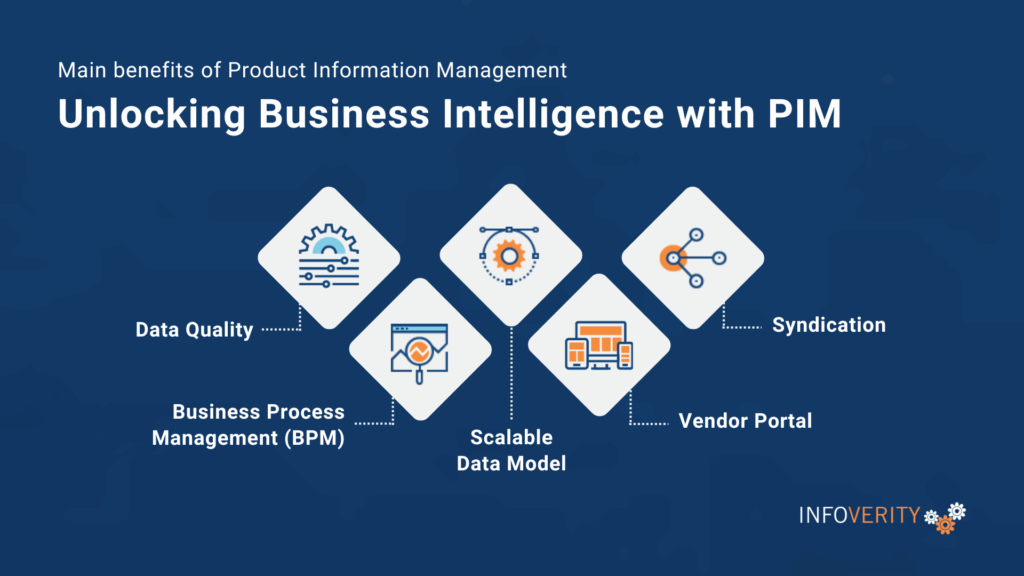Every product has a story. And this translates to loads of data, which can overwhelm product-based businesses. So, what is PIM? And which role plays in this?
Back in the day, customers only had to visit a store or browse a catalog to make a purchase. But now, people shop on websites, online marketplaces, and social media. It has become difficult for businesses to keep up with all the product information they need from different channels to create a cohesive customer experience.
This is where product information management (PIM) steps in. In this article, we’ll talk about what it is, the best use cases for it, and the most popular software tools on the market.
What is PIM: Table of Contents
What is PIM?
Product information management (PIM) refers to the overseeing, developing, and enriching extensive product information and its associated assets. Thus, it involves managing data related to marketing or selling of a company’s goods.
Data-driven companies leverage PIM systems to form a strong framework for a company’s product data. In fact, these solutions reduce friction in tracking cross-functional product information, including—but not limited to:
- Basic details: Product names, SKUs, UPCs
- Technical information: Size, color, material, weight, warranty period
- Digital assets: Product images, social media reels/videos
- Marketing information: Product description, target persona, channel-specific marketing information (ex: SEO keywords)
- Sales information: Pricing details, stock availability, upsell and cross-sell recommendations
Which are The Most Popular PIMs?
Product information management systems ensure accurate, consistent, and accessible product data across channels. For instance, here are the top five most popular solutions on the market that large organizations should consider:
- Informatica: MDM – Product 360 is Informatica’s product information management solution, designed for managing digital commerce and transforming businesses with innovative product experience.
- Stibo Sytems: The platform offers necessary tools and technologies for establishing a single source of truth and improving operational efficiency.
SMEs should consider:
- Akeneo: The tool collects, imports, onboards, and distributes product information. It has a free offering called Akeneo PIM Community Edition.
- InRiver: The platform promises to power dynamic product stories. It can present complete, compelling, and compliant product information across the value chain, maximizing profitability.
- Contentserv: This all-in-one solution aims to help organizations eliminate data silos, centralizing product information and streamlining business operations.
Infoverity partners with these software tools, as well as other leading providers. Get to know them here.
Looking for PIM guidance in your company?
If you’re looking to satisfy your consumers’ expectations about quality information and nudge them toward buying, Infoverity can help you implement and manage your product data better. 
What are some of the main benefits of a PIM?
Enterprises generate copious amount of data every day, with product information being just one crucial subset. Thus, having a tool that helps with effective product data management is essential for achieving business intelligence.
- Data Quality: Poor data quality inhibits 56% of businesses to capitalize on data. An enterprise product information management system ensures data consistency, accuracy, and completeness through a centralized platform.
- Business Process Management (BPM): 74% of businesses have shown interest in leveraging BPM. PIM systems do more than streamline product information. In fact, they also streamline the workflows related to it, improving overall operational efficiency.
- Scalable Data Model: As enterprise expands and develop, so do their product portfolio. Furthermore, every step customers take produces data that can be tied to the products. The right system adapts to these needs without compromising performance.
- Vendor Portal: PIM-powered vendor portals facilitate vendor collaboration and communication, enabling them to share accurate and up-to-date product information.
- Syndication: 75% of consumers demand consistency across channels–this includes product information. Thus, PIM systems streamline the exchange of product information between e-commerce sites, marketplaces, and partners.

How are PIM solutions used?
These solutions prove its value and efficiency in the following use cases:
Digital Commerce and New Sales Channels
An HBR study proved that 73% of shoppers prefer to shop in more than one channel. Thus, a product information management solution manages an organization’s product information and streamlines internal collaboration. It gathers, clean, and distribute relevant information across various sales channels.
Example
Canadian outdoor retailer SAIL turned to InRiver solution to help with their ecommerce journey. The brand struggles with managing its massive multi-brand catalog. InRiver provided a centralized, reliable source of product information.
Data Governance and Quality
Data accuracy plays a big role when implementing a product information management solution. In fact, companies looking to maximize this investment need to require cross-functional teams to check and clean their data.
Moreover, PIM solutions themselves, like Akeneo, have features to help brands like fast fashion company boohoo to quickly track and measure product data quality and consistency.
Vendor Onboarding
Seamless vendor onboarding speeds up time to market and improves vendor relationships. By using product management solutions, enterprises have a better platform for vendors to submit data for validation.
For instance, many tools, such as ContentServ, come with AI-powered features that streamline the process, such as data validation at import.
Data Proliferation
Modern businesses face the issues that stem from explosion of data. This includes data silos, disparate systems, and difficulties in sharing information.
When Kmart Australia worked on expanding their online reach, they first implemented a PIM system for general merchandise. But they quickly realized that it didn’t have the scalability and functionality needed to house their entire product catalog (45,000 SKUS) online.
As a way to centralize and manage product information more accurately, the company switched to Informatica MDM – Product 360 and Informatica Data Quality. Doing so enabled Kmart Australia to maintain and manage a constantly evolving online product database.
How does a PIM differ from other product-related software?
It’s easy to confuse product information management solutions with other software solutions enterprises use. Here’s what makes them different:
CMS vs PIM
CMS (Content Management System) facilitates online content creation and publishing. PIM organizes and manages product information.
MDM vs PIM
Master Data Management (MDM) tools deals with a broader range of data. PIM concentrates on product data alone.
PDM vs PIM
Both handle product-related data and workflows. However, PDM houses product development-related information, while PIM handles marketing and sales-related product information.
Conclusion
A company’s strategy to manage product information across channels and brands relies on its PIM solution.
If you’re looking to satisfy your consumers’ expectations about quality information and nudge them toward buying, we can help you implement and manage your product data better. Contact us today.
FAQs – What is PIM?
What is PIM?
Product information management (PIM) refers to the overseeing, developing, and enriching extensive product information and its associated assets. It involves managing data related to marketing or selling of a company’s goods.
What is the objective of the PIM?
PIM systems help businesses centralize and streamline product data across multiple channels. By reducing friction in managing cross-functional product information, PIM solutions enable data-driven companies to deliver seamless customer experiences and enhance operational efficiency.
What are the benefits of a PIM?
A PIM system enhances workflows, improves operational efficiency, and supports scalability as enterprises grow and product portfolios expand. They also facilitate vendor collaboration through portals and streamline data syndication to meet consumer demands, enabling businesses to capitalize on accurate data and deliver seamless customer experiences.
How are PIM solutions used?
PIM solutions centralize and streamline product data across channels, enhancing digital commerce, improving data quality, and optimizing vendor onboarding with AI-powered validation. They also solve challenges from data proliferation, enabling businesses to manage vast product catalogs efficiently.



